Communication on mars
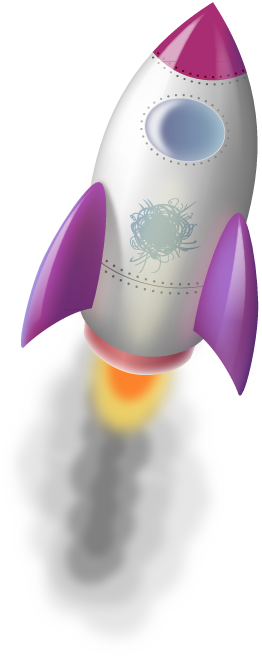
April 12 is the international day of manned space flight. More than half a century has passed since the moment when Humanity took the first step in its development. A series of brilliant technical and scientific victories made us closer to the stars. Thirst for discoveries pulls to comprehend new mysterious worlds. Mars, the red "star" in the sky, from ancient times attracted the attention of people. Unimaginably similar to the Earth, but still the alien world still does not leave the minds of many researchers. Probably in a short time we can witness how small research colonies of people will appear on Mars. Engineers will face many problems. At Habré there is a large number of specialists in different areas, each has a broad outlook and certain knowledge. I propose to use the collective mind and in this article to reflect on how communication on Mars would look if there were colonies of people there.
This discussion paper discusses the hypothetical technical task of organizing communications on Mars between research human settlements. For the participation of readers of different levels of training, the article provides brief descriptions of some basic technical terms, focusing on the principles of open optical communication using lasers, as well as some questions about the design of stationary communication satellites.
')
Illustration: 21, characters: 45 081.
As a starting point for discussion, below are some of my reflections on this issue, as well as a concise description of some radio engineering concepts. More experienced readers can only get acquainted with brief abstracts at the end of each section.
When designing any system, you should always clearly represent its main purpose. Often, it is not so easy to form a template of functions and strictly follow it. This article discusses the task, the purpose of which is to create a concept of a telecommunication system for organizing communication between research stations on Mars. It is assumed that stations can be separated from each other by an arbitrary distance. Most likely, the main network traffic will be research data, such as telemetry of various instruments, audio and video streams. Although it is not necessary to deny that the constant presence of a person on Mars will serve as an impetus for creating a local global network with various services of a non-research nature, for example, something entertaining. In this case, the task of synchronizing the local global network with the Internet on Earth may appear. This task is far from simple and its solution should take into account many nuances. Any technical project in addition to scientific ambitions should be based on economic feasibility. It should be noted that the deployment of not any telecommunications system will be justified. Many people know that the main highways of the modern Internet on Earth operate on optical communication lines . Applying this experience on Mars is probably not optimal, because the optical line needs to deploy infrastructure on the planet. What is not desirable, as usually when talking about research stations, they suggest a kind of local settlement of researchers, where centralized technical support is organized. And as already noted, it is not at all necessary that another research station will be located nearby. In addition, any reasons can serve that will have to leave the settlement. Taking into account the above, it is necessary to analyze various options and try to choose the optimal one, the use of group discussion will allow to take into account many factors. Before starting the discussion, a few words should be said about the features of the red planet.
Step 1. Mars
Mars is the fourth planet of the solar system. It is slightly smaller and lighter than Earth. On Mars, a very rarefied atmosphere is cooler than on Earth, but despite this, Earth and Mars have common features.
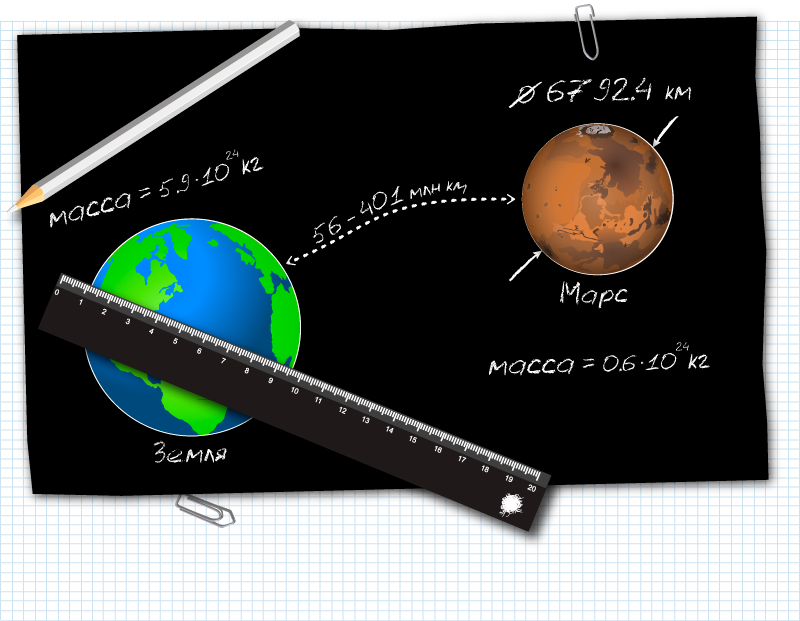
A day on Mars lasts just like on Earth: almost 24 hours (24 hours 37 minutes 23 seconds) . Seasons are also present, although due to a longer orbit around the Sun, they last longer. The sky is blue and there are even white clouds. However, the Martian bothersome dust can probably give the surrounding landscape a reddish tint. The approximate structure of the atmosphere of Mars is presented on the application below.
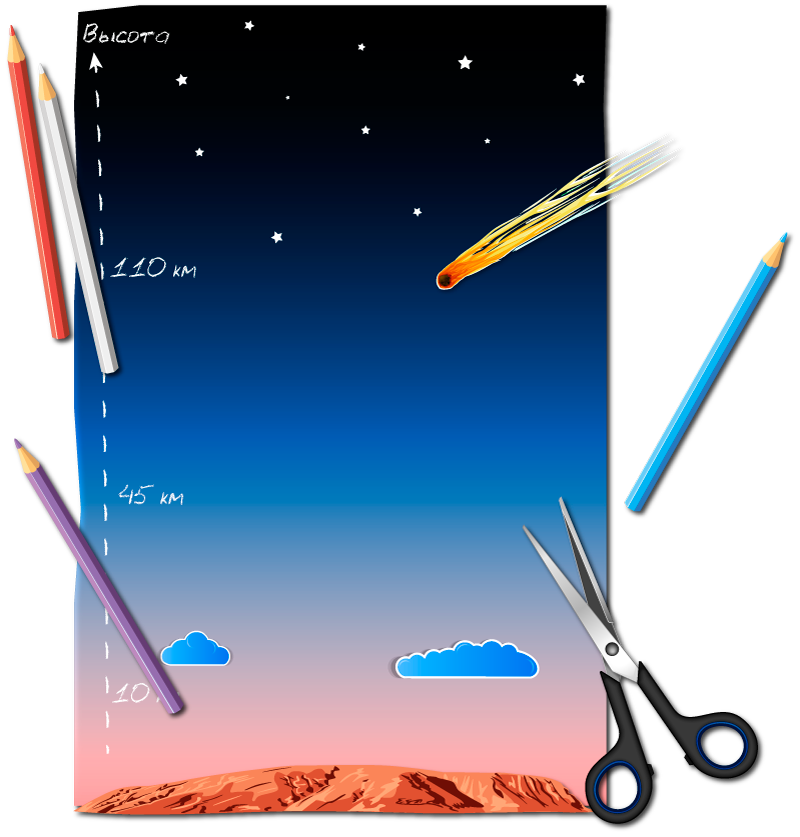
Because of the low atmospheric pressure, a very weak magnetic field, frosty weather and a low concentration of oxygen in the atmosphere, a person on Mars will have to move in special suits, perhaps easier than a regular spacesuit, or in specialized cars. Otherwise, the person will die in seconds from asphyxiation or explosive decompression . To protect against radiation, you will most likely have to build stations under a layer of soil, the entrance to which will need to be provided with gateways. Perhaps a typical Martian station would look like this:
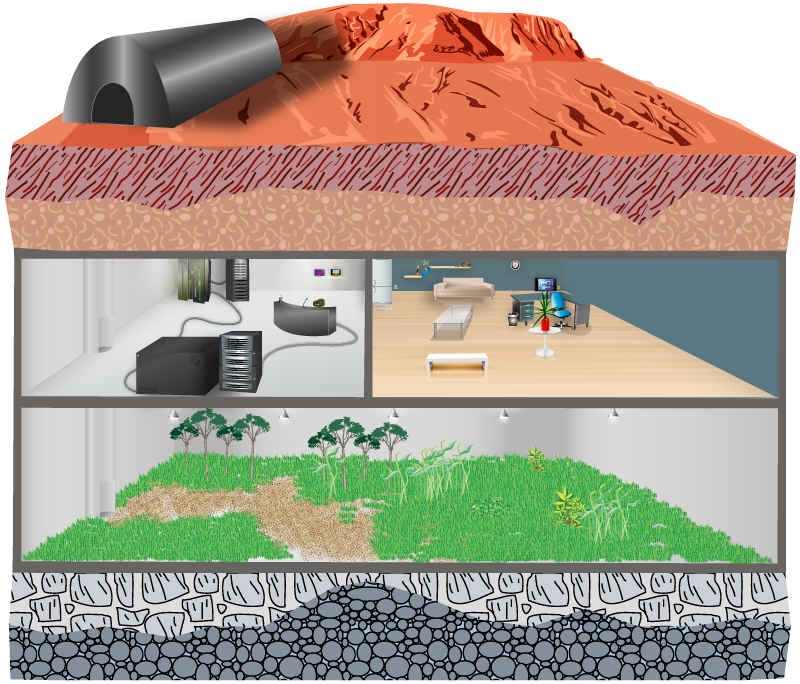
More details about Mars, its features and issues of colonization can be found in the additional literature, links to which are given at the end of the article.
Mars is an interesting celestial body, which is very similar to the Earth and is at a distance accessible to modern technology. Colonization of Mars will allow using its resources for industrial purposes, and planetary features create ideal conditions for the space industry and for research and for launching spacecraft (the second space velocity on Mars is lower than on Earth).
Step 2. Communication lines
Many space powers in their space programs suggest future exploratory colonization of Mars. Therefore, as noted above, it should be assumed that there may be several different research stations on the planet, separated from each other by an arbitrary distance and which will need to organize among themselves a reliable communication channel with a sufficiently large bandwidth. The bandwidth of the channel here is understood as the maximum amount of information (in bits) that can be transmitted via this communication channel in a second. In the literature, this concept can also be found under the name "channel capacity" (channel capacity) .
Deploying infrastructure outside research stations is not desirable, since it incurs unnecessary costs and complicates the project, so the use of fiber optic communication lines on the planet (the best solution on Earth) is not optimal. Thus, the only available solution, in which it will not be necessary to build additional facilities, will be the use of wireless technologies.
Modern wireless technologies use electromagnetic waves as a carrier of information. The main reason why the choice fell on electromagnetic waves is the speed and "range" of their propagation. In free space, waves in electromagnetic fields can propagate at a speed of about 299,792,458 meters per second and cover long distances! For example, the exchange of information using sound is in fact also a wireless communication technology, where waves propagate in a substance (for example, in air molecules) , but much inferior in terms of propagation velocity and “range”.
The range to which electromagnetic waves can propagate is not limited by anything, but in practice it depends on the energy carried by the electromagnetic wave. When propagating in space, energy is constantly lost, because electromagnetic waves interact with atoms and molecules of the medium. Therefore, the more energy an electromagnetic wave carries, the more distant it can be “seen”. In fact, at very high energies, interesting physical effects begin to arise in the medium, which lead to the fact that the problem of information transfer
with the help of such waves is complicated. In technical applications, the parameter - power, which shows how much energy a wave carries per unit of time, is more often used. In more detail this issue is covered in the above sources.
You can see that two waves, spreading in one direction and one distance, lose a different amount of energy. This suggests that besides power, other wave parameters should also be taken into account. In physics, oscillations and waves are closely related processes that are defined mathematically by similar formulas and essentially the same parameters. The most important is the oscillation frequency or wave frequency. This parameter characterizes the speed of the process. The time for which one oscillation occurs is called the period, and the distance that the wave travels during this time is called the wavelength. Frequency and wavelength are related. The greater the oscillation frequency, the shorter the wavelength. Therefore, it is equally possible to use both the concept of frequency and the concept of wavelength, understanding the connection between them. It is the frequency (length) of an electromagnetic wave that essentially determines how much energy is lost in a particular medium. This is inextricably linked with quantum physics and the features of the structure of matter. This question is quite complicated and has a huge number of nuances.
It is important to see which electromagnetic waves lose more energy in the main medium for propagation - the atmosphere of Mars, and which are smaller. It should be understood that the atmosphere of Mars is only carbon dioxide, nitrogen and oxygen with some admixtures of other gases, including water vapor. Therefore, the main contribution to energy loss will be associated with these gases. You can take a look at the figure below, which shows graphs showing attenuation (energy absorption) in water vapor and oxygen at different frequencies (wavelengths) . Although the graphs show a relatively small portion of frequencies (wavelengths) , however, it can be seen that among the whole range of frequencies (wavelengths) there are areas where the attenuation is less than in the rest. This is the so-called "window of transparency." For the exchange of information just use such frequencies (wavelengths) .

The amount of energy absorbed at different frequencies can vary in a sufficiently large range, therefore, in engineering practice, for convenience, use the logarithmic scale of relative units. This is convenient in that it eliminates the records of large numbers and reduces calculations. Since the scale uses relative units, it operates with relationships. The unit of measurement for this relationship is dB (decibel). For example, it is not necessary to write that the electromagnetic wave has weakened when propagating 1000 times, it is enough just to write at 30 dB. The figure explains the principle of conversion to this scale.

In engineering, it is also convenient to switch to a relative logarithmic scale and for absolute values, they are simply divided (normalized) by some predetermined convenient number. So, to describe the power, which is usually measured in watts (W), a unit is entered - dBm (decibels per milliwatts). To do this, the power is simply divided by 1 mW (milliwatts) .
The power and frequency range of a signal propagating in the form of an electromagnetic wave are related to the bandwidth of a real communication channel by the famous Shannon formula, which is shown in the figure below.
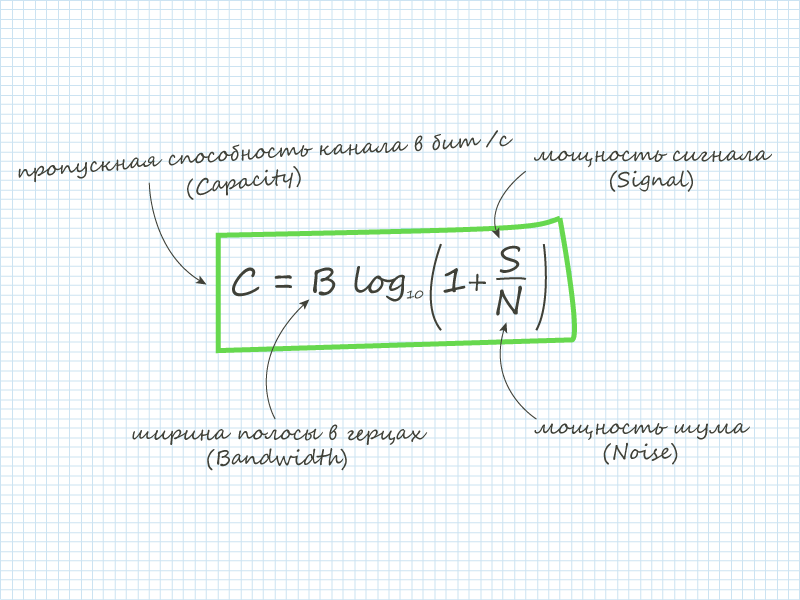
The fact that such a signal and its spectrum and how they are interconnected have already been mentioned here in this article . Let me remind you that in nature many physical processes are oscillatory (harmonic) in nature, including electromagnetic waves. Therefore, in applied science disciplines, where they operate on signals, the mathematical apparatus of spectra (a set of simple oscillations) has received wide application. As noted above, signal propagation is associated with energy transfer. In the language of the spectra, each elementary oscillation (harmonic) of a signal carries some part of the total energy of the entire signal. And the frequency range that contains 99% of the energy is called the signal band (according to the FCC version) , which appears in the Shannon formula. The fair question may be why not 100%? The fact is that all the signal energy is spread over all frequencies, i.e. real signal bandwidth has infinite width. Such a concept is not very informative and there is no practical benefit from it, since There is a frequency range where the main energy of the signal is concentrated, which determines its properties. It becomes clearer if you look at the picture.
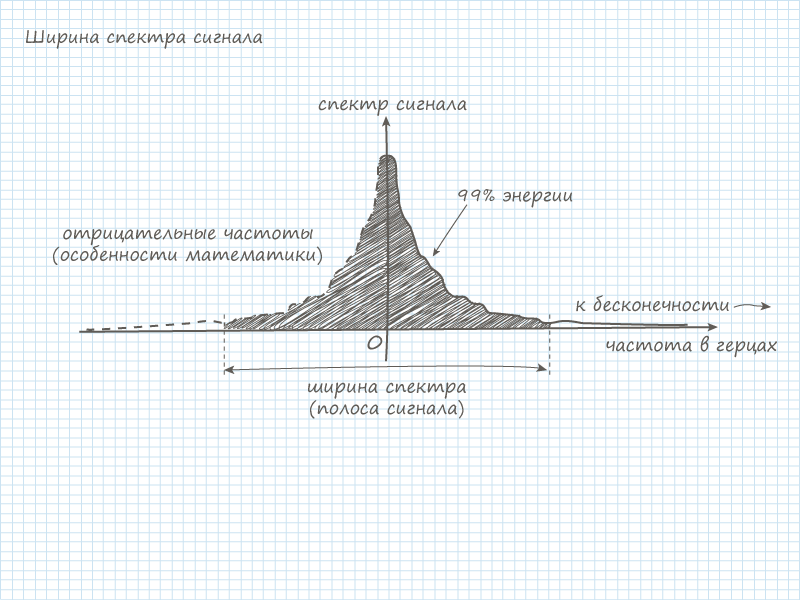
There are other definitions of the signal bandwidth, but they are all ideologically similar, the difference is only in the convenience of definition for a particular application. Additionally, you can read about it in the literature cited at the end of the article.
Thus, in order for the considered communication system to have the necessary bandwidth, it is necessary to select the frequency range (wavelengths) , the signal band and its power. All these values are actually limited, the reasons for this are the subject of a separate discussion. It will not be a mistake in this article to assume that these boundaries do not exist, since the values of the band, power and frequency in real systems are far from the limit. The transmission of information by electromagnetic waves is carried out by high-frequency signals, the frequency of which must be matched with the windows of the atmosphere to minimize power loss. This frequency is called the carrier. Data is entered into this signal by modulating the carrier frequency. The frequency of the modulating signal is proportional to the bandwidth of the resulting (after modulation) signal. Usually in telecommunication systems, the band is much smaller than the carrier frequency, because in this case the resulting (after modulation) signal is not much different from the harmonic form (a wide signal band means the presence of high-frequency components in the signal spectrum, which gives a more complex signal shape ) . This is necessary in view of the fact that the equipment is imperfect and in order to eliminate possible distortions, with the propagation of electromagnetic waves, this requirement must be fulfilled. The figure below shows the principle of signal modulation in the language of spectra.
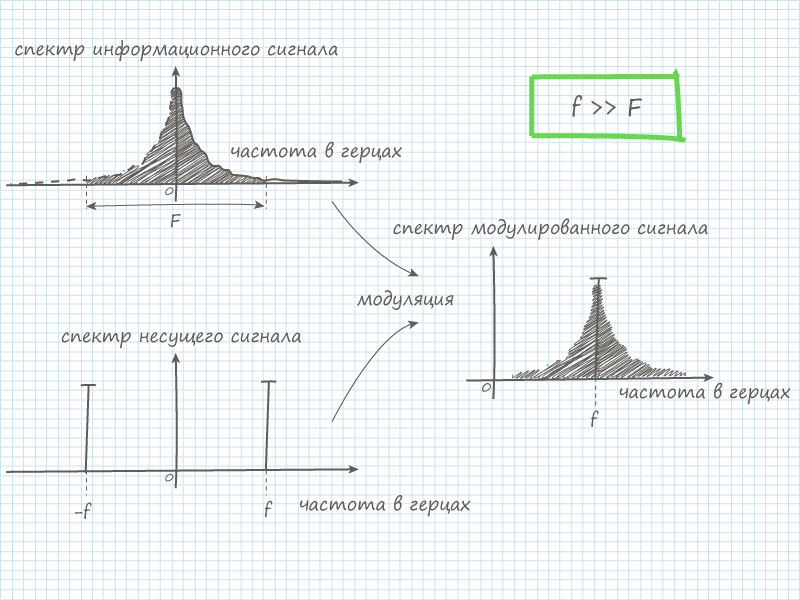
Ultimately, it can be concluded that to transmit a large flow of information, a wider frequency band is needed, which will require a higher frequency carrier, respectively (to preserve the harmony of the signal) . For transmission on a single data carrier in gigabit, you need an approximately bandwidth in gigahertz (a conditional estimate that allows you to see orders of magnitude) , which ultimately leads to a requirement for a carrier several orders higher than the band - terahertz, which corresponds to the optical range. In the optical range, it is customary to use not the concept of frequency, but wavelength. Let me remind you that these are equivalent concepts. The terahertz frequency range corresponds to the nanometer wavelength range.
Among other things, the concept of polarization is associated with the phenomenon of wave propagation. This is an interesting phenomenon, the description of which has a clear mathematical character. If you do not go into details, then this is a definite orientation of the wave in space. Two propagating electromagnetic waves in the same direction at the same frequency with different polarizations can attenuate differently. The figure below shows a visual analogy of the polarization (orientation) of the waves. More information about this phenomenon can be found in the electrodynamics literature. When transmitting over a very long distance through a medium with different distortions, taking into account the polarization of an electromagnetic wave loses its relevance.
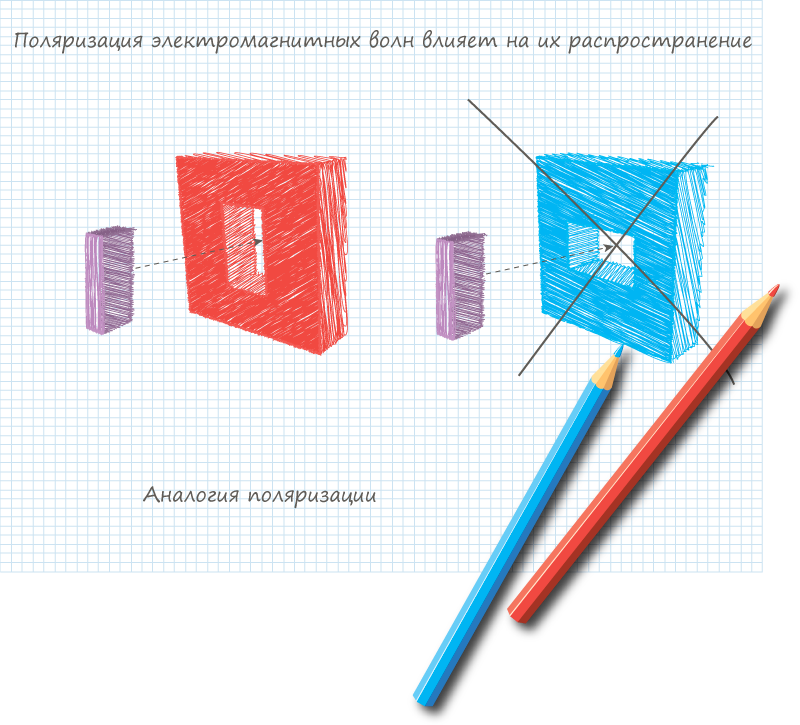
To visualize the picture of the propagation of electromagnetic waves of any range, it is enough just to look around you. After all, light, as was said above, is also an electromagnetic wave. These are waves of a very narrow frequency range, the power (intensity) of which is recorded by a person’s eyes. Various effects: glare, shadows, penumbra, etc. - all this is inherent in waves and other frequencies. It is worth noting that the propagation of waves of different frequencies is differently influenced by the surrounding objects. For example, for waves at some frequencies, a single rocket on the desert plain of Mars will be an obstacle to propagation, while others simply will not notice it. Thus, the propagation of electromagnetic waves, in addition to the environment, is also influenced by the surrounding objects. Depending on the geometrical dimensions of the objects, the waves can either be reflected from them, or bend around, or scatter on them. Electrodynamics is also studying the problems of the propagation of electromagnetic waves in space.

By analogy with light, it is sometimes convenient to represent the propagation of radio waves in the form of rays. Then, for the exchange of information, the sender emits an electromagnetic wave in the direction of the recipient, which in turn receives it. If there is an object on the path between them that the beam cannot go around, then the wave is reflected or scattered and the recipient will not be able to receive the information. If the objects are large, there are several of them and they are located somehow very difficult, for example, a huge number of houses in the city or the complex rocky relief of the surface of Mars, then the recipient may be able to receive a ray that will be either direct or reflected from some object, a few rays may be taken. This phenomenon is called multipath propagation. For someone who accepts an electromagnetic wave, this effect can cause some trouble. For example, it is possible that the recipient will receive several rays and they will form so that the rays neutralize each other and the recipient does not see the electromagnetic wave. This phenomenon is called fading. More information about the specifics of the distribution can be found in the additional literature.
The movement of the sender or recipient also causes certain changes in electromagnetic waves, including those that can lead to fading. However, the main effect is that when moving for the receiver, it seems that the frequency (length) of the electromagnetic wave changes. This phenomenon is called the Doppler effect . Mobile communications systems must take into account the effect of this effect. The effect is widespread and ubiquitous everywhere where there are wave processes. There are also variations of this effect, which can lead to a number of interesting phenomena that can be read in more detail in the literature.
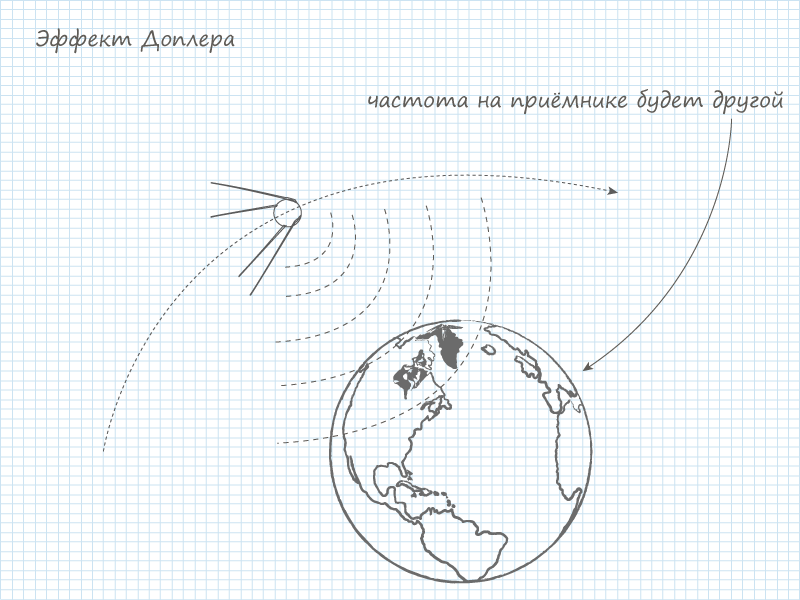
When propagating to farther distances, more and more various factors need to be taken into account, including the meteorological situation, the structure of the atmosphere and the curvature of the surface of Mars. Modern terrestrial wireless communication systems operate at a relatively short distance in the lower atmosphere - the troposphere, so the propagation of electromagnetic waves can be influenced only by rain or snow, and as stated above everything depends on the size of the rain particles (snow) and frequency (wavelength) . The situation is similar on Mars, but mainly dust acts as scattering particles. If it is necessary to organize communication with the near-planetary space (space) , then for this it is necessary to take into account the passage of electromagnetic waves through the troposphere, the ionosphere, to consider the curvature of the beam during propagation, etc. All these phenomena are present both on Mars and on Earth, the difference lies in the order of effects, since everything is conditioned by the strong rarefaction of the atmosphere of Mars.
Any electromagnetic radiation is characterized by power, private range (wavelengths), polarization. When propagating from a receiver to a transmitter, electromagnetic waves can be exposed to various negative factors, which ultimately leads to a decrease in the capacity of the wireless channel (the Shannon formula) or a complete loss of communication. To organize the wireless communication between stations with a large bandwidth, it is necessary to use electromagnetic radiation in the optical range. This requirement arises from technical considerations. When selecting the operating frequency (wavelength) it is necessary to take into account the “transparency windows”, as well as the presence of dust in the atmosphere of Mars. Due to the strong rarefaction of the atmosphere, many effects have little effect on the propagation of radiation. In the optical visible range, the attenuation in the atmosphere is negligible. The best sources of radiation in the optical region are lasers. Let's see what possible systems can be built on this principle.
Step 3. Laser channel
This is the so-called FSO technology (free space optics) . It is a sufficiently developed technology on Earth and is used to replace wired communication lines, especially fiber paths, in places where it is profitable. The main requirement for the communication line is the conditions of direct visibility between the receiver and the transmitter. However, in conditions of Mars with such a condition, the use of the system can be quite inefficient, because in the lower atmosphere there can be a high concentration of dust, which will lead to strong light scattering and, as a consequence, a decrease in throughput or a loss of signal. In addition, the line-of-sight distance is limited by the curvature of the planet's surface. The situation can improve the use of relay stations, however, this method is not acceptable, because will lead to the organization of additional infrastructure. More ambitious and effective will be the use of a repeater in the stationary orbit of Mars.

, , , .. ( - , ) .

, , , . . , , 17 000 , 100 — . wikipedia .
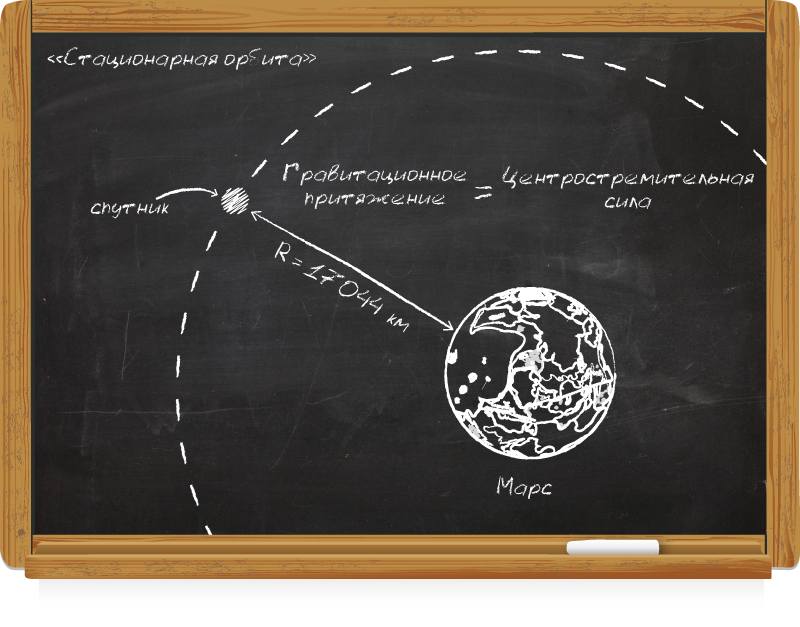
, , . . , , .
- , , .. , , ( ) . ( , ) .
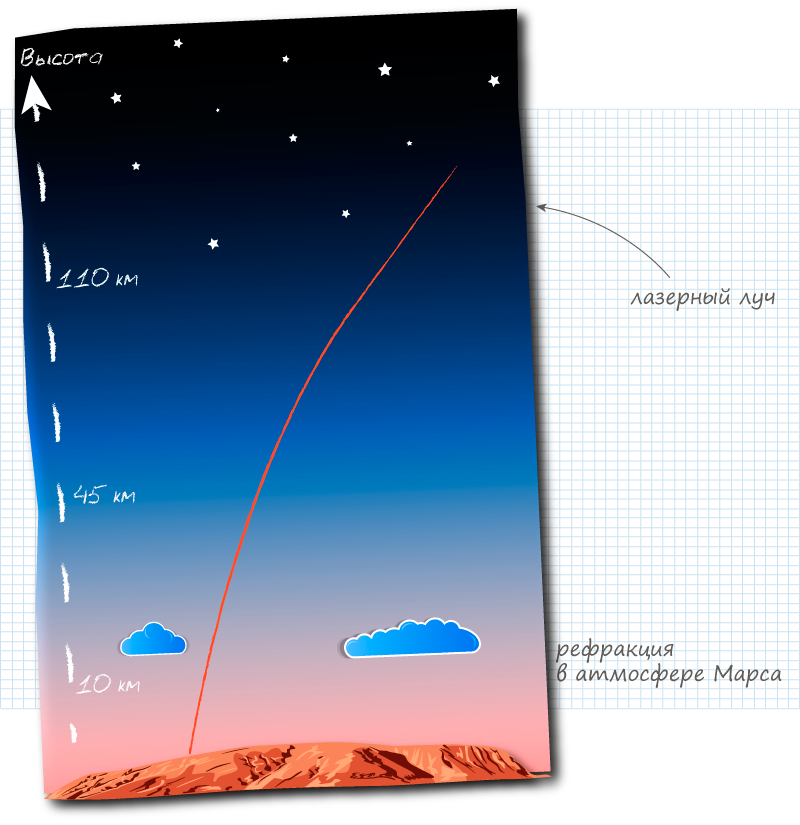
, ( ) . , () . - . , «» . , . , . , , . . 500 ( ) . , () .
, , , . , () , , . , . , , , . .

, , ( ) , .. . , . , , , . , , . , — ( ) , , . ( ) , — . , , . . , . , , . , , , , () () , () () . , .

, . , . ( ) , . , . , . , : - , , , . . , :
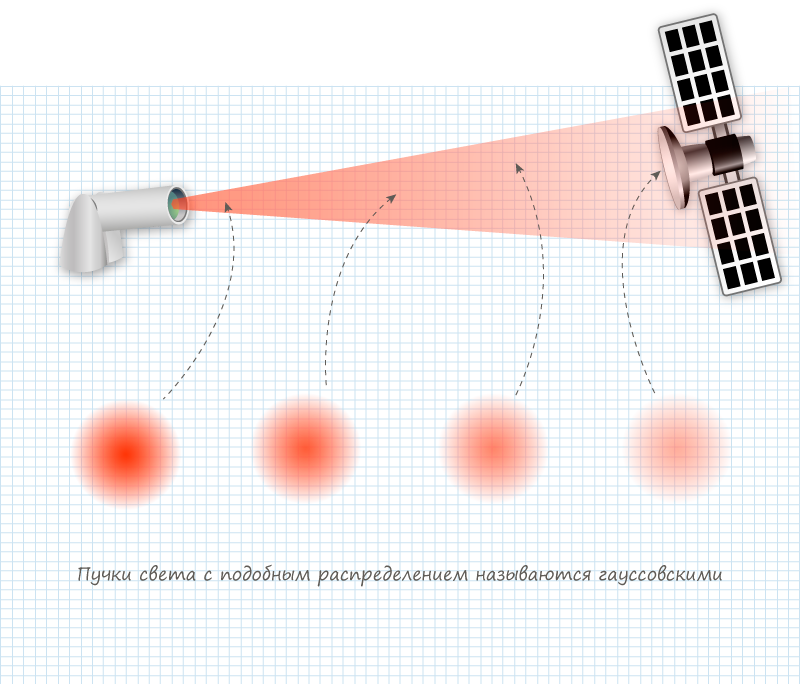
, , . , . , . , . ( , ) . , . , - . , .
, ( 1- ) 17 000 42 . , . , , , , , 32 . , 20 , , 50 -> (). uplink, () — > downlink. , - . , , .
, .. ( ) , , ( ) ( ) . , . (APD) c PIN . , . . . , — . , , . . , -30 . . .
50 -30 20 . 30 , , ( aka — « ») . 1 . , ( DVD 200 23 ) . . , , , , .
, , . , . , . , .
FSO . . - , . , ( ).
4.
— . .
, . , . - , ( ) , , . . , . , . , — , ( ) . .
. , . , . , , , ( : - - ) . , ESARAD , THERMICA ..
The hardware computing part is conventional electronics, with the exception of probably increased requirements for fault tolerance, low power consumption, heat transfer, dimensions and mass. From the standpoint of architecture, there are usually no serious differences with terrestrial electronics. Typically, a multiprocessor architecture is used, where there is one main processor, which distributes the calculations between the others, in case of its damage any other processor can become the main one. The system is complex, but allows you to provide the necessary reliability. Tires, interfaces, memory is similar to a normal ground system. The main danger lies in the impact of radiation, which can lead to disruption of the logic of the digital circuits, voltage changes in the operational amplifiers, increased heat generation, etc. Many problems can be dealt with by constantly checking the checksums at the hardware and software levels, error correction ( special codes) , as well as redundancy (duplication of iron in whole or in part) .
As for the software, the requirements for them are very severe: hard real-time for systems controlling flight, position and service connection with the surface and less troublesome
By the time for various operations related to the mission of the flight, in the case of a telecommunication satellite, this is the control of switching equipment. In this case, the system can be controlled under the usual quick operating system, perhaps some kind of Kolibri OS build. Software development for such systems is a very responsible and difficult task. In any such systems, 90% of the time is spent on testing and planning, including using specialized CAD systems such as SpecTRM-RL (Specification Tools and Requirements Methodology) , and only 10% on coding itself. More information about the development of software for satellite systems can be found in the following literature.
For the laser channel under consideration, the optical part on the satellite is very important, and specifically the optics, which will receive the signal and direct it to the photodetector, which was discussed in the previous section. To characterize this optical system, it is convenient to use the concept of the radiation pattern from antenna theory. If you do not go into details, such a diagram is usually viewed in a certain plane of the receiver, where it is shown what signal level will be received when the receiver is irradiated from different angles. In such systems, there are "blind zones", from where radiation will never fall directly into the receiver. For the laser channel, this means that the surface area of Mars with which you can establish communication with the satellite will be limited (in any case, the restriction will be, but of greater radius and due to the horizon). A specific solution to this problem may be the use of “faceted vision” technology. The basis of this technology is the design of the eyes of a fly , which is able to see around itself at 360 °. Thus, it is possible to increase the viewing angle of the satellite, as it is conditionally shown in the figure below.

Facet vision can provide connectivity between transponder satellites, and possibly with other celestial bodies, such as Phobos or Deimos , but this is a task of a higher order of complexity.
The use of a satellite repeater satellite in a stationary orbit in a laser communication channel entails an increase in the complexity of the project, but at the same time it gives a number of advantages, mainly in increasing the communication range. Limited resources on the satellite dictate certain requirements to the architecture, for example, it may be difficult to use lasers with the power of a similar transmitter on Mars, in which case you need to use weaker emitters and compensate for this with a receiver on the other side with a larger aperture (receiving area).
Step 5. Data Transfer
The laser communication channel considered in the article allows to cover a large number of telecommunication needs, for example, such a channel can provide audio and video transmissions between stations, not to mention telemetry transmissions. This is not surprising if we note that in the estimates, quite realistic system parameters were obtained for a bandwidth of 1 Gbit / s.
The optical channel is not stable in the sense that the occurrence of any unforeseen factors will lead to loss of communication. For example, the occurrence of a dust storm will weaken the channel in hundreds of decibels, which does not give any opportunity for the transmission of information. To prevent this, a redundant radio channel must be included in the system. On the similarity of those that are now on Earth are used in satellite communications. The capacity of such a channel is much lower, but in the event of unforeseen circumstances there will be at least some connection. The radio channel can also be useful when the optical system is induced, because less sensitive to orientation. To provide lightness in the guidance of the laser radiation can be slightly defocused, which will create a larger spot on the receiving side, which is easier to get into the satellite. After communication is established, the system can be re-focused, while ensuring that the maximum radiation is at the receiver, in which case the transmitter will be strictly directed to the receiver.
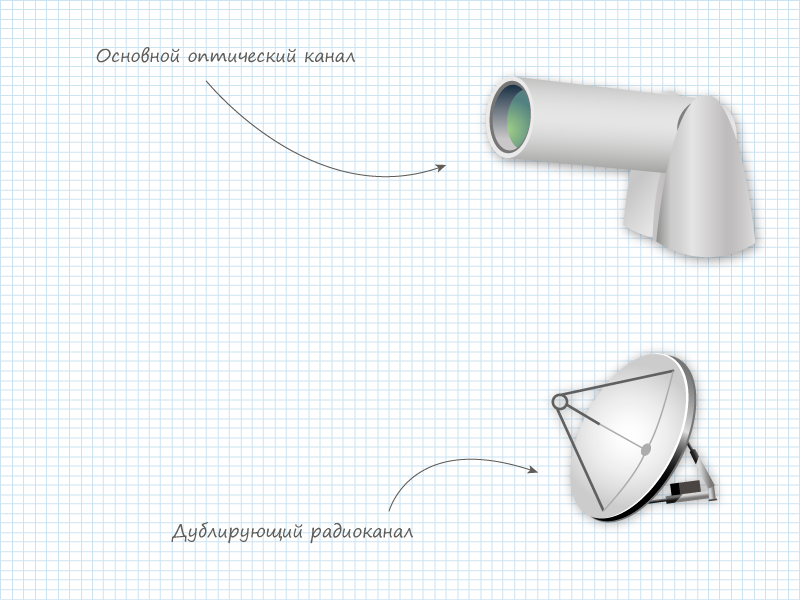
The solution to the problem of transmitting information in the absence of communication through the main channel can be found in other ways. Technologies do not stand still and it is likely that alternative data transfer systems will soon appear, on new sources. Recently, researchers were able to conduct an experiment on the transmission of data by a neutrino beam. Naturally, the experiment is far from practical application, but now it is already possible to see that, taking into account the penetrating capabilities of neutrinos, it is possible to transmit messages over long distances in almost any conditions. This will be especially useful if there is a need to transfer information to the other side of the planet directly through the planet.
Most likely the optical communication channel will interface with some fiber network, which is an excellent solution for the “last mile” . In this case, you need to think about the harmonization of standards. Most likely, the entire network will be built according to the SDH architecture (this channel will be able to provide the STM-16 level) , and it will be necessary to ensure the synchronization of the repeater with the terminals. Probably it would be more correct to put the quantum frequency standard, as the most accurate electronic device, on the repeater and broadcast a signal to the planet for synchronization over the radio channel, then all communication channel systems will operate synchronously.
As for mobile systems, for example, rovers or vehicles for transporting people, they will most likely have to deploy some radio channel at ultrahigh (300-3000 MHz) or ultrahigh (3-30 GHz) frequencies, which will provide decent communication in a certain radius. Inside the station, if it is large, the radio system may be broken down into a kind of LTE , WiMAX . If a serious distance from the station is meant, then it is possible to put a high antenna and at longer lengths to communicate with more distant objects. This issue has already been resolved within the framework of technical problems on Earth, where there are many different systems of long-distance and short-range communications.
The existence of a global network on Mars from a number of research stations and relay satellites is likely to require synchronization with earth services. The whole problem here is in signal delay. With a “short” distance between the planets, it will take about 3 minutes to transfer the wave packet. In the worst case, about 20 minutes . This requires a certain approach when designing services for Martians on Earth and earthlings on Mars. Alternatively, you can use the solutions that are currently used in version control systems .
This article proposed a topic for discussion about a hypothetical communication system on Mars between research stations. A brief description of some basic technical terms for attracting a larger circle of readers of different levels of training is given. As a basis, the idea of using an open optical communication channel through a satellite repeater in the stationary orbit of Mars, as well as some prerequisites for solving a number of related technical problems, was argued. Find the answers to the questions that will help list of books and articles below. I will be glad to see ideas and suggestions (especially cardinally different) for solving the problems discussed.
Step 6. Read
- Ho Christian, Nasser Golshan and Kliore Arvydas. Radio wave
Propagation Handbook for Mars. - Nasa Mars facts.
- CE Shannon and W. Weaver. The mathematical theory of information.
- Bronshten V.A. Planet Mars.
- Landau, L. D., Lifshits, E. M. Field Theory.
- Grudinskaya G.P. Distribution of radio waves.
- Nikolsky V. V. Electrodynamics and radio wave propagation.
- Pimenov Yu. V. Technical electrodynamics.
- D. Shannikov. Technical electrodynamics. Antenna devices and the propagation of electromagnetic waves.
- Malykin G. B. The Sagnac effect. Correct and incorrect explanations.
- Goldstein LD, Zernov N. V. Electromagnetic fields and waves.
- Wertz. James R. and Wiley J. Larson. Space Mission Analysis and Design.
- Leach, Ronald J. Introduction to Software Engineering.
- Masafumi Katahira, Nancy G. Leveson. Use of SpecTRM in Space Applications.
- Pisacane, Vincent L. and Robert C. Moore. Fundamentals of Space Systems.
- Solomatin V. Facet Vision.
- Inka Hublitz. Engineering concepts for inflatable Mars surface greenhouses.
- MIT SM Architecture Thesis of Georgi Petrov.
- Plesiochronous digital hierarchy and E1 stream ( esendjer ).
PS Follow the resource rules and terms of the Creative Commons Attribution 3.0 Unported (CC BY 3.0)
PPS The article is quite voluminous, I admit the existence of typos, incorrect expressions and formulations. Please write comments to me through private messages. I will try to make the article better. Thank.
Source: https://habr.com/ru/post/141904/
All Articles